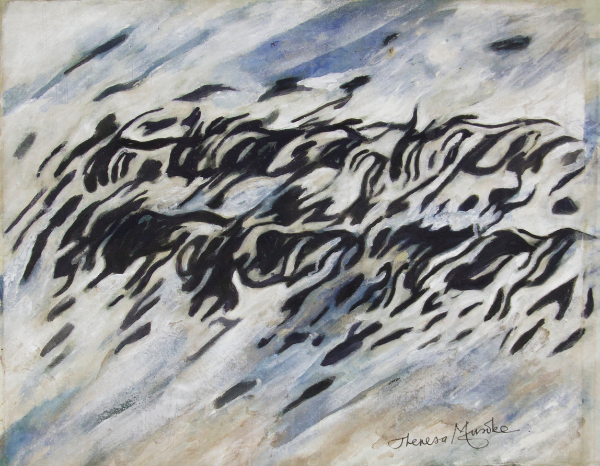
An interview with Theresa Musoke
Musoke considers herself a semi-abstract painter and is best known for her expressive portrayals of the region’s abundant wildlife, using a range of mediums to develop her imagery.
Read More
Musoke considers herself a semi-abstract painter and is best known for her expressive portrayals of the region’s abundant wildlife, using a range of mediums to develop her imagery.
Read More
Working together for a decade now, Bárbara Wagner and Benjamin de Burca have been producing films and video-installations in dialogue with other artists connected to sound and stage. Learn more about their practice and recent exhibitions.
Read More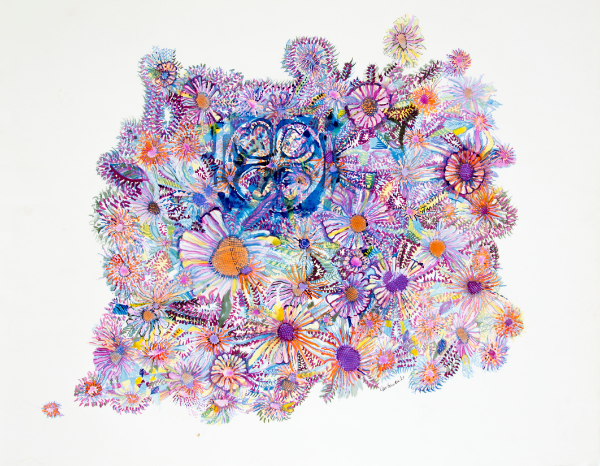
Gor Soudan is a conceptual artist living and working in Kisumu and Nairobi. Often subtly engaged with contemporary political and social issues and embedded in urban culture, Gor’s artistic practice is an organic process through which everyday material is transformed into powerful work.
Read MoreI am always looking for a new story that allows me to better understand the complexities of life. [/vc_column_text][/vc_column][/vc_row][vc_row][vc_column width="1/2" css=".vc_custom_1607937168279{padding-right: 20% !important;padding-left: 0px !important;}"][vc_column_text css=".vc_custom_1622457772710{padding-left: 5% !important;}"](SS)You have stated that you are interested more in the history of the common individual rather than macro level narratives and historical constructions. What drew you to this, and how do you think about your own artistic interventions within this?
(RMH): In Cuba, daily interaction among individuals is very common. The economic limitations of the country have led all Cubans to try to be like a big family in which we help each other a little. In the neighborhood everyone knows each other and some know more about one or the other. Stories and neighborhood gossip are in the air. However, unlike the great stories of history, there is no guarantee that the individual events of the common individual will remain for the future. Only art has the will and the ability to activate these little micro-historical stories. I am interested in how the individual creates the little stories of him[self] from memory. Alfons Cervera said that "History is built on the inescapable basis of the truth of the events it relates. But sometimes history is also built with the additions of memory. And memory, we also know, is the sum of the accuracy and inaccuracy of memories ". Memory is possibly the only space of absolute freedom where you can unconsciously modify the story. Modifying that information, it is there, in the inaccuracy of the memory, where I am interested in constructing new narratives. Memory is a container of memories, more or less organized, that we store and that we forget or keep according to our priorities and desires. Memory is fiction, with recesses full of real and unreal situations, which we are nesting according to the life history that we build. But, the history should not be fiction; There is a rigor that solves it and that, depending on how you look at it and explore it, reveals real events that set guidelines and offer true data from a time already past. I work from that flexibility between history and memory; in that sway that moves between a real, verifiable event, a family memory or a social scene, and the new historical construction that I give to that rescued memory. I try to create an atmosphere where reality and fiction complement each other, rather than tense. It is like a poetics of loss. I select fragments of a certain historical memory and, arbitrarily, according to my ideas -which may come already preconceived or arise spontaneously at the same moment that I am looking at the thousands of photos that I have accumulated during these years of work- I build my own history, the one that I invent from that residual reality perpetuated in photographs. And I am referring to a poetics of loss because nothing, absolutely nothing of what I choose and manipulate ever again means the same as before I dismantle them from their historical matrix.[/vc_column_text][vc_empty_space][/vc_column][vc_column width="1/2"][vc_single_image image="7655" img_size="full" alignment="right"][vc_empty_space][vc_column_text]Artwork by Ricardo Miguel Hernández[/vc_column_text][vc_empty_space height="150px"][vc_column_text]Memory is possibly the only space of absolute freedom where you can unconsciously modify the story.
[/vc_column_text][/vc_column][/vc_row][vc_row][vc_column width="1/2" css=".vc_custom_1607937168279{padding-right: 20% !important;padding-left: 0px !important;}"][vc_column_text css=".vc_custom_1622457761973{padding-left: 5% !important;}"](SS) Who do you see as the audience for your work? How does the filter into how you construct or present your work? (RMH): I do not work for a specific audience. Although my work is generally seen within the artistic circuit, I am always struck by the new looks of people who are not contaminated by the knowledge of art. In those looks, sometimes naive, I can find many answers to what I am doing. The works are made to be exhibited live, but in these difficult times of Covid-19 I have found a space that I had not previously exploited: the digital platform. This type of space has allowed me to make three virtual exhibitions "When the memory turns to dust I", on the website www.theexhibit.io, "When the memory turns to dust II", at EL PRAN Projecten, both curated by Yenny Hernández Valdés and "From fragment to landscape", on Artsy with gallery owner and curator Nuria Richards. Also publications of my work in digital magazines such as Rolling Stone (Italy), ARTDOC Photography Magazine, LENSCRATCH and Faire Mondes have made [my work] more visible in these confinement times. (SS): Your ongoing series When the memory turns to dust amplifies your desire to investigate personal archives and memories. Where did the title for this series come from? (RMH) The title of the series "When the memory turns to dust" is based on the idea that many times I felt frustrated when I bought or acquired a photo and did not know its history. Even when the purchase came from a relative, many times there was no way to determine beyond what the image offered, that is, a coherent account of what really happened. Only the individuals involved in the image can narrate the events. These works made from collage, which I have been working on for more than two years, are based on the need to collect and archive all kinds of vernacular photographs, mostly, dated between the decades of the 20s and 80s; to later make symbolic and semiotic reconstructions creating different scenarios that project possible realities of Cuban and international history. They are stories built from the assembly from the different micro- stories that each image presents. And this construction is possible when the images do not present in most cases a fact or a known personality. As an exception, I have incorporated the Cuban commander Fidel Castro into this series because of the magnitude of photographs that I have found and because he is an icon that helps me create absurd situations from the very political context of my country.[/vc_column_text][vc_empty_space][/vc_column][vc_column width="1/2"][vc_single_image image="7657" img_size="full" alignment="right"][vc_empty_space][vc_column_text]Artwork by Ricardo Miguel Hernández[/vc_column_text][vc_empty_space][/vc_column][/vc_row][vc_row][vc_column width="1/2" css=".vc_custom_1607937168279{padding-right: 20% !important;padding-left: 0px !important;}"][vc_column_text css=".vc_custom_1622458330178{padding-left: 5% !important;}"](SS): What are important thematic considerations for your practice? (RMH): Although in this series I have gone from portraits to scenes with more historical or social content, the landscape is possibly the subject on which I have worked the most. The Cuban landscape, whether urban or rural, is juxtaposed with other foreign landscapes serving as scenery to project diverse realities, deviating from the origin where each image segment came from. (SS) Could you please share more about your process of creating work, including where you get the images that you manipulate in your work? Perhaps you could share the process for creating by referencing specific artworks and how you went about making them? (RMH) I live every day in a constant search for a photographic archive. Before Covid-19, it was very normal to see myself rummaging through drawers and drawers in different people's houses. It is an almost performative process in which I undertake the task of locating the photographic archive in various places, both at different people's homes and at antique markets. I even bought many photos in a town as far away as Banes, in the city of Holguín, in the eastern part of the country. On two occasions, two friends sent me packages of photographs from the United States. At this time, the search is slower due to the confinement situation. I have a large collection, so I take the search slower until the situation gets better. (SS): How have the works in the When the memory turns to dust series evolved since you began? (RMH): I feel like the stories in the collages have become more complex, more interesting. I take my time to think of the idea and study it more carefully. On many occasions I resort to the sketch as a preliminary study of what I will do later. That makes the collage more effective in its content and more interesting. (SS): What is the latest work or series of works that have been added to When the memory turns to dust? Could you please share more about what inspired their creation? (RMH) One of my last works was an assembly of an American car, possibly from the early 1950s, with a crown of flowers on top, which sails away at sea. Behind you can see a reunited family watching the game and, much further back, a fragment of a stadium with many people participating in the event. It is a work that talks about a constant reality in our history; exile and emigration. The flight to a better future. The painful goodbyes. Families fractured by political differences. Those who left and those who couldn't leave. Those who tried to leave and did not succeed. [/vc_column_text][vc_empty_space][/vc_column][vc_column width="1/2"][vc_single_image image="7660" img_size="full" alignment="right"][vc_empty_space][vc_column_text]Artwork by Ricardo Miguel Hernández[/vc_column_text][/vc_column][/vc_row][vc_row bwd_tbc4vd_show_weekday="" gap="35" row_show_on="hide_on_normal_screen,hide_tablet_landscape,hide_tablet_portrait,hide_mobile_landscape,hide_mobile_portrait"][vc_column width="1/2"][vc_single_image image="773" img_size="full" alignment="center"][vc_empty_space][vc_column_text]Mus re officillupta non preri ut oditibere, quaecab orerum remod ut essequis antia quaeperumqui officiet earum res[/vc_column_text][vc_empty_space height="150px"][vc_column_text]Mus re officillupta non preri ut oditibere, quaecab orerum remod ut essequis antia quaeperumqui officiet earum res veliatemolor adigeniamet ditatur sam nullupt isquodi cum fugit, vit fugitem quis cumquae. Mus re officillupta non preri ut oditibere, quaecab orerum remod ut essequis antia quaeperumqui officiet earum res veliatemolor adigeniamet ditatur sam nullupt isquodi cum fugit, vit fugitem quis cumquae. Mus re officillupta non preri ut oditibere, quaecab orerum remod ut essequis antia quaeperumqui officiet earum res veliatemolor adigeniamet ditatur sam nullupt isquodi cum fugit, vit fugitem quis cumquae. Mus re officillupta non preri ut oditibere, quaecab orerum remod ut essequis antia quaeperumqui officiet earum res veliatemolor adigeniamet ditatur sam nullupt isquodi cum fugit, vit fugitem quis cumquae. Uptaquaepudi alias dolorepudi si dolupta ium deliquis sanit alicimusanis vel ium ratiisc ipiciistios dolectur, andignam nonsectest rem volorporro molorpo reperovitat et la volo volupta vernam aut aliqui ut doloressit quiduci aerfers perchicit ma ius magnimpero vel magnime nonectore voles quae sume nobiti debis int, omnihitin nosam, con eum voluptate officimped que nima quo[/vc_column_text][/vc_column][vc_column width="1/2"][vc_single_image image="774" img_size="full" alignment="center"][vc_empty_space][vc_column_text]Mus re officillupta non preri ut oditibere, quaecab orerum remod ut essequis antia quaeperumqui officiet earum res[/vc_column_text][vc_empty_space height="150px"][vc_column_text]Mus re officillupta non preri ut oditibere, quaecab orerum remod ut essequis antia quaeperumqui officiet earum res veliatemolor adigeniamet ditatur sam nullupt isquodi cum fugit, vit fugitem quis cumquae. Mus re officillupta non preri ut oditibere, quaecab orerum remod ut essequis antia quaeperumqui officiet earum res veliatemolor adigeniamet ditatur sam nullupt isquodi cum fugit, vit fugitem quis cumquae. Mus re officillupta non preri ut oditibere, quaecab orerum remod ut essequis antia quaeperumqui officiet earum res veliatemolor adigeniamet ditatur sam nullupt isquodi cum fugit, vit fugitem quis cumquae. Mus re officillupta non preri ut oditibere, quaecab orerum remod ut essequis antia quaeperumqui officiet earum res veliatemolor adigeniamet ditatur sam nullupt isquodi cum fugit, vit fugitem quis cumquae. Uptaquaepudi alias dolorepudi si dolupta ium deliquis sanit alicimusanis vel ium ratiisc ipiciistios dolectur, andignam nonsectest rem volorporro molorpo reperovitat et la volo volupta vernam aut aliqui ut doloressit quiduci aerfers perchicit ma ius magnimpero vel magnime nonectore voles quae sume nobiti debis int, omnihitin nosam, con eum voluptate officimped que nima quo[/vc_column_text][/vc_column][/vc_row][vc_row][vc_column][vc_single_image image="7657" img_size="full"][vc_empty_space][vc_column_text]Artwork by Ricardo Miguel Hernández[/vc_column_text][/vc_column][/vc_row][vc_row][vc_column][vc_single_image image="7658" img_size="full"][vc_empty_space][vc_column_text]Artwork by Ricardo Miguel Hernández[/vc_column_text][/vc_column][/vc_row][vc_row][vc_column][vc_single_image image="7656" img_size="full"][vc_empty_space][vc_column_text]Artwork by Ricardo Miguel Hernández[/vc_column_text][/vc_column][/vc_row][vc_row][vc_column][vc_single_image image="7659" img_size="full"][vc_empty_space][vc_column_text]Artwork by Ricardo Miguel Hernández[/vc_column_text][/vc_column][/vc_row][vc_row][vc_column width="1/2"][vc_custom_heading text="CREDITS" font_container="tag:h1|font_size:50px|text_align:left|color:%23ff3350" use_theme_fonts="yes"][vc_empty_space][vc_column_text]Artworks by Ricardo Miguel Hernández. [/vc_column_text][/vc_column][vc_column width="1/2" css=".vc_custom_1605372363845{padding-right: 0px !important;padding-left: 0px !important;}"][/vc_column][/vc_row][vc_row bwd_tbc4vd_show_weekday="" top="0px" bottom="0px" row_show_on="hide_on_normal_screen,hide_tablet_landscape,hide_tablet_portrait,hide_mobile_landscape,hide_mobile_portrait"][vc_column][vc_column_text] [/vc_column_text][/vc_column][/vc_row]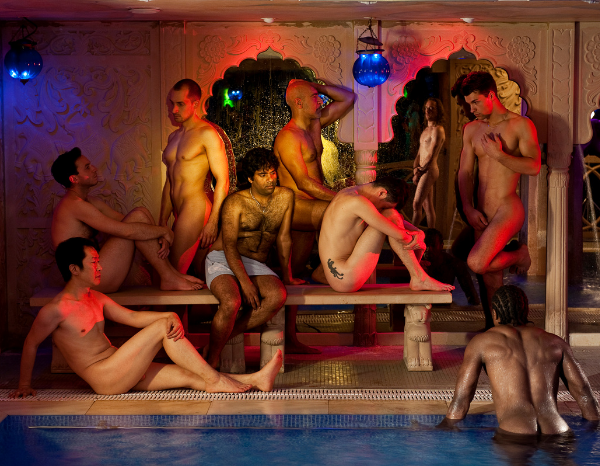
The show invites audiences to experience temporal and epistemic shifts translated through the affective visual delicacies produced through Gupta’s optical lexicon.
Read More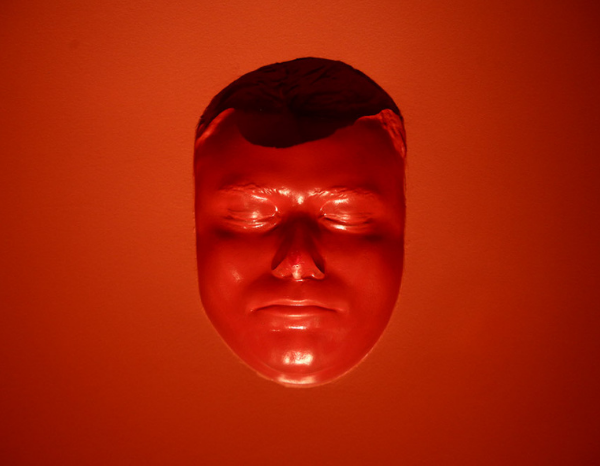
The Foundation emerged from collectors Lekha Poddar and her son Anupam Poddar expanding their personal interests in art to facilitating wider public engagement with artistic practice and curatorial interventions.
Read More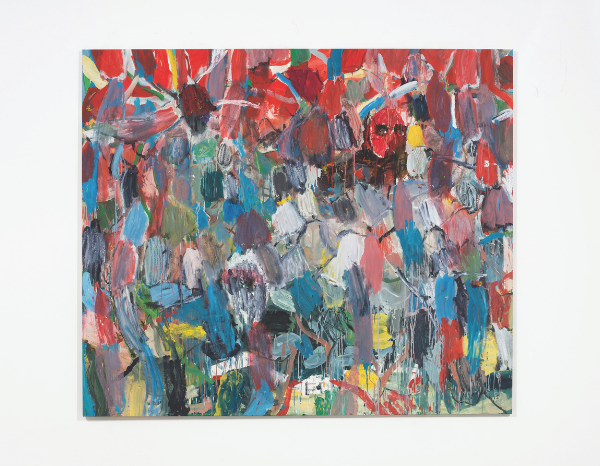
Learn more about Misheck Masamvu’s practice and artistic journey through a conversation with curator and educator Gabi Ngcobo that took place in Johannesburg, South Africa on 3 October 2018. This conversation formed part of Masamvu’s catalogue titled ‘Still’.
Read More